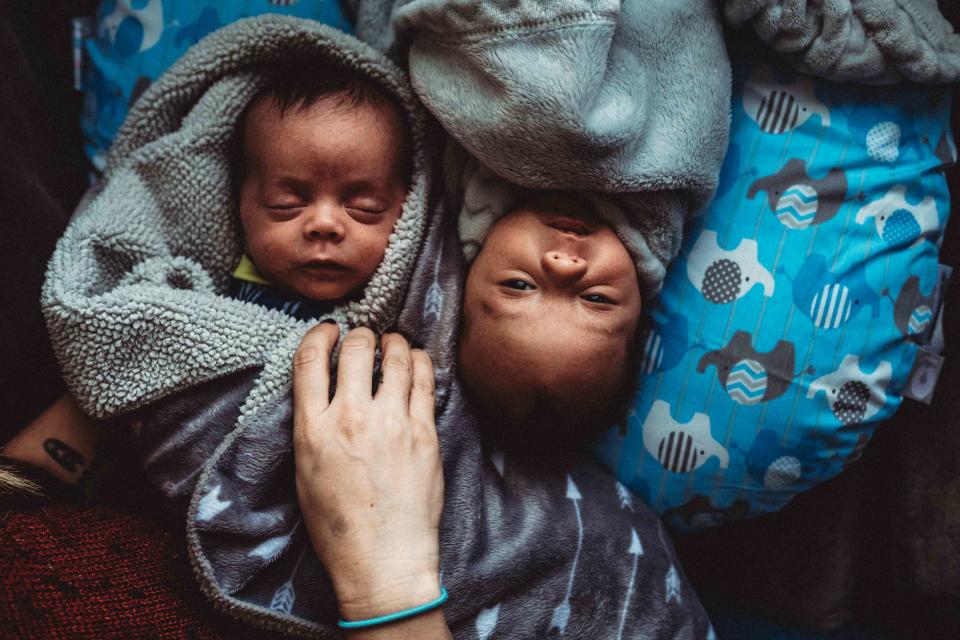What Are Mono Mono Twins?
Monoamniotic twins are a special type of identical twins

Jill Lehmann Photography / Getty Images
Medically reviewed by Renita White, MD
Identical twins that share a placenta (the fetal organ providing oxygen and nutrients to the fetus during pregnancy) and an amniotic sac (a fluid-filled sac surrounding the fetus in-utero) are called monochorionic-monoamniotic or mono mono twins. This happens in about 0.1% of all pregnancies and 1% of twin pregnancies.
Learn about mono mono twins, potential complications when two fetuses share a placenta and amniotic sac, carrying to term, and more.

Jill Lehmann Photography / Getty Images
Mono Mono Twins on Ultrasound
An ultrasound during the first trimester of pregnancy is up to 98% accurate in determining if twins share a placenta and amniotic sac. However, it can be difficult to tell if twins are mono mono before the ninth week of pregnancy. This is important to know to monitor for possible pregnancy complications.
Since the placenta and amniotic sac are shared, all mono mono twins are identical twins, meaning they share the same genes and originate from the same egg, which split into two after fertilization.
Risks of Carrying Mono Mono Twins
The risks are higher for mono mono twin pregnancies than for other twin pregnancies. The survival rate for mono mono twins is 70%. However, healthcare providers can offer guidance to improve outcomes and reduce the risk of complications. This is why it is crucial to determine if the fetuses share a placenta and amniotic sac in the first trimester of pregnancy.
Risks associated with mono mono twin pregnancies include:
Amniotic fluid levels that are too high or low: Amniotic fluid levels are affected by a blood supply that is high or low in one twin and can lead to complications such as heart failure.
Different growth rates: One fetus may receive more nutrients, restricting the growth of the other.
Entangled umbilical cords: When the umbilical cords get knotted, it can prevent oxygen and nutrients from reaching the fetus.
Premature birth and low birth weight: Even without complications, healthcare providers recommend that mono mono twins are delivered before 37 weeks gestation to prevent serious complications. If you experience pregnancy complications, your provider may recommend an earlier delivery.
Twin reversed arterial perfusion (TRAP): This occurs when one fetus has an underdeveloped heart and relies on the other fetus to pump blood.
Twin-twin transfusion syndrome (TTTS): One fetus receives more nutrients from the placenta, putting the other at risk for complications, such as organ failure.
Regularly see a healthcare professional such as an obstetrician-gynecologist (ob-gyn) whenever pregnancy, twin pregnancy, or monochorionic-monoamniotic twin pregnancy is suspected or discovered.
With monitoring and care, risks associated with mono mono twin pregnancies can be prevented and treated.
Carrying Mono Mono Twins to Term
It is possible to carry mono mono twins and deliver healthy babies. While there are increased risks, the survival rate after 24 weeks of gestation may be as high as 97%. It is best to seek care early in pregnancy and to continue monitoring throughout pregnancy so that any possible complications are diagnosed and treated as early as possible.
Mono mono twins are typically delivered between 33 and 34 weeks to treat current complications and prevent additional complications from occurring later in pregnancy. Some mono mono twins are born vaginally, though most are delivered via Cesarean section (C-section). The timing and mode of delivery depend on the health of the gestational carrier, fetal health, and pregnancy progression.
Identical Features of Mono Mono Twins
In identical twins, the egg splits into two after fertilization, so the genes of both fetuses are the same. They may not look the same, but they will always be the same sex, both girls or boys. Because they have the same genes, they are more likely to look the same compared to fraternal twins or non-multiple siblings, but they can develop differently throughout pregnancy. For example, one may be noticeably bigger than the other, and their fingerprints are not the same.
Summary
Mono mono twins are a rare type of identical twins that share one placenta and amniotic sac. An ultrasound done in the first trimester of pregnancy is the best way to determine if you are carrying mono mono twins.
The survival rate for mono mono twins is 70%, meaning there is an increased risk compared to people pregnant with one fetus or twins with separate placentas and amniotic sacs. Mono mono twins are generally delivered between 33 and 34 weeks to treat and prevent complications. If you are carrying mono mono twins, attending all of your appointments and working closely with a healthcare provider to monitor and reduce the risk of complications is crucial.

